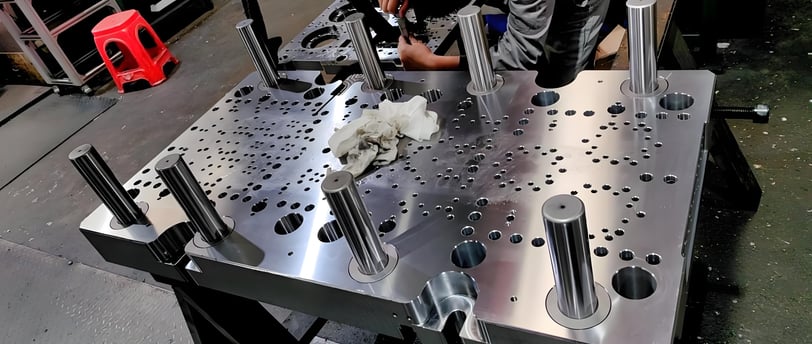10 Ways to Improve Stamping Die Productivity
1/20/2025


Regular Maintenance and Inspection
Conducting regular maintenance and inspections on stamping dies is essential for ensuring their optimal performance and longevity. Stamping dies are crucial components in manufacturing processes, and any malfunction can lead to decreased productivity and increased costs. Implementing a routine maintenance schedule not only preserves the functionality of the dies but also enhances the overall production efficiency.
One of the best practices for maintaining stamping dies is to conduct routine checks for wear and tear. Inspecting dies for signs of damage, such as cracks or deformation, allows for early intervention and timely repairs. Identifying issues before they escalate can significantly reduce the risk of unexpected downtime, which can be detrimental to production schedules. Regular inspections should also include evaluating the alignment and calibration of the dies to ensure they are operating correctly.
Cleaning is another critical component of stamping die maintenance. Accumulated debris and lubricants can adversely affect the operation of the dies, leading to poor-quality output and potential damage. A consistent cleaning regimen, utilizing appropriate solvents and techniques, will help maintain the precision and efficiency of the stamping process. Additionally, proper lubrication of the dies is vital for minimizing friction and wear, thus prolonging the lifespan of the components.
Finally, scheduling timely repairs is imperative. Addressing minor issues immediately can prevent them from developing into major problems that disrupt production. Furthermore, keeping a detailed maintenance log can facilitate tracking performance over time, assisting in predicting when significant repairs or replacements may be necessary. Ultimately, proactive maintenance strategies foster a safer and more efficient working environment, ensuring that productivity remains at an optimal level in stamping operations.
Optimizing Die Design
Investing in optimal die design plays a crucial role in enhancing stamping die productivity. A well-designed die not only improves the efficiency of the stamping process but also reduces downtime and maintenance costs. Several factors should be considered when designing a die, each directly impacting productivity rates.
First and foremost, material selection is pivotal. High-quality materials that offer durability can withstand the rigors of high-volume production. Using tool steel variants like D2 or S7, which possess great hardness and toughness, can contribute to longer die life and fewer replacements. These materials can also maintain precision, resulting in fewer defects and reduced scrap rates.
Geometry is another key factor in die design. The shape and configuration of the die components should facilitate effective material flow. For instance, incorporating features such as radiused corners can minimize stress concentrations and improve the overall wear performance of the die. Additionally, considering the thickness and layout of the material being stamped can prevent issues such as wrinkling or tearing, which can compromise productivity.
Furthermore, features that enable faster setups significantly enhance productivity. Quick-change tooling systems can be integrated into the die design to streamline adjustments and swaps between different jobs. This capability reduces the time spent on setup, allowing for quicker transitions between production runs. Furthermore, the inclusion of alignment features can simplify the assembly process, ensuring precise positioning of the die components.
Examples of design modifications leading to significant improvements include the use of progressive dies that allow multiple operations to be completed in one pass, thereby increasing the production rate. Likewise, the introduction of binder mechanisms can enhance material flow during stamping, accelerating the overall production cycle. By focusing on these design factors, manufacturers can achieve measurable gains in stamping die productivity.
Implementing Advanced Technologies
Advanced technologies play a pivotal role in enhancing stamping die productivity by streamlining processes and improving precision. Automation is one such technology that significantly minimizes human error and enhances efficiency. By automating repetitive tasks within the stamping process, companies can achieve faster turnaround times while maintaining consistent quality. This shift not only frees up skilled labor for more complex roles but also reduces operational costs in the long run.
Computer-aided design (CAD) is another critical technology that facilitates the creation of precise die designs. CAD software allows engineers to visualize and simulate die structures in a virtual environment, fostering innovation and creativity. The use of CAD in stamping die design leads to higher accuracy and decreases the time taken to bring a new product to market. Additionally, CAD systems can be linked with CNC machinery, resulting in a seamless transition from design to production, further enhancing overall productivity.
Simulation software is equally significant, enabling manufacturers to analyze die performance before physical production begins. By assessing variables such as material flow and stress concentrations, companies can identify and rectify potential issues early in the design phase. This proactive approach reduces the likelihood of errors that could arise during production, which often lead to costly reworks. Moreover, employing simulation tools assists in optimizing the die lifecycle, ensuring that all components function in harmony, thereby enhancing productivity throughout the stamping process.
Integrating Industry 4.0 solutions into stamping operations is another step toward realizing improved productivity. The use of data analytics, IoT, and machine learning allows for real-time monitoring and predictive maintenance of stamping equipment. This technological synergy fosters a more agile production environment, where manufacturers can make informed decisions based on precise data insights. Overall, implementing advanced technologies such as automation, CAD, and simulation software can significantly elevate stamping die operations, resulting in reduced errors and higher efficiency.
Training and Skill Development of Operators
In the realm of stamping die productivity, the proficiency of operators plays a pivotal role. Skilled operators are not just a desirable asset; they are essential to maximizing the efficiency and effectiveness of stamping operations. To cultivate a capable workforce, establishing comprehensive training programs is crucial. These initiatives should cover foundational operational procedures while also delving into troubleshooting techniques and an in-depth understanding of die mechanics.
When designing training programs, it is important to ensure that they are well-structured and tailored to meet the specific needs of the manufacturing environment. Begin by conducting an assessment to identify the skill gaps among operators. Utilizing this data can inform the development of targeted training modules that address these deficiencies. Training should not only focus on the technical aspects but also emphasize safety procedures to create a secure working environment. This ensures that operators can work efficiently without compromising their well-being.
One effective approach is to adopt a hands-on training methodology. Operators should have opportunities to engage directly with equipment, allowing them to apply theoretical knowledge in a practical setting. Additionally, mentorship programs can be beneficial, pairing less experienced workers with seasoned veterans. This promotes knowledge transfer and fosters a collaborative workspace culture.
Moreover, incorporating continuous learning and development into the workplace can significantly enhance the operators' skill set. Regular workshops and refresher courses on emerging technologies or advanced die designs can keep operators updated with industry advancements. By creating an environment where learning is encouraged and valued, companies can enhance their workforce’s capabilities continuously.
In summary, investing in the training and skill development of operators is indispensable for improving stamping die productivity. A well-educated and skilled workforce not only contributes to efficiency on the shop floor but also enhances overall operational performance.
